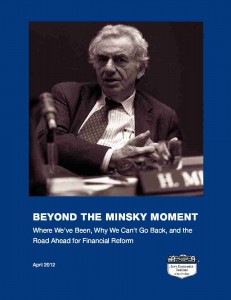It’s Hard to Fix What You Don’t Think Is Broken
In last week’s Bloomberg column, Peter Orszag (former head of CBO and OMB) lamented that most “official forecasters” relied (and still rely) on economic models that led them to completely underestimate the severity of the downturn that resulted from the subprime mortgage crisis. These “bad models,” as Bloomberg‘s headline writers call them, whiffed badly on the most critical economic question of the day, says Orszag, because they ignored financial leverage.
Jared Bernstein points to Hyman Minsky as an economist whose work stands out for taking finance seriously. But although Minsky’s account of financial fragility is fairly well known nowadays, less attention is being paid to his related proposals for reregulating and restructuring the financial system. And as Jan Kregel and Dimitri Papadimitriou point out, there is an intimate connection between how we think about the generation of financial fragility and how we approach financial reform. The limitations of the Dodd-Frank approach to regulation, we might say, are in part a reflection of our continuing neglect of the implications of the endogenous creation of instability:
As Minsky emphasized, you cannot adequately design regulations that increase the stability of financial markets if you do not have a theory of financial instability. If the “normal” precludes instability, except as a random ad hoc event, regulation will always be dealing with ad hoc events that are unlikely to occur again. As a result, the regulations will be powerless to prevent future instability. What is required is a theory in which financial instability is a normal occurrence in the system.
… While best known for his analysis of financial fragility, Minsky was primarily concerned with providing guidance for proposals to create a financial structure that ensures a stable transaction system and provides for the capital development of the economy. Until we internalize his vision of financial fragility, however, we are unlikely to be able to design a financial architecture that more reliably meets these twin objectives. Whether the next crisis delivers a more convincing lesson remains to be seen—the limitations of the Dodd-Frank approach make it likely that we won’t have to wait long to find out.
Read the one-pager here.




 ShareThis
ShareThis